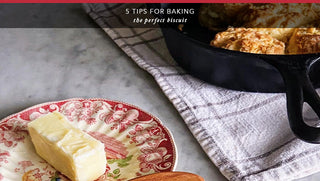Biscuits from Wren: My Top Five Tips for Baking the Perfect Biscuit
I grew up in a tiny village named for a tiny bird. Wren is nestled among green, stacked foothills that stretch like giant doorsteps to the William B. Bankhead National Forest in Lawrence County, Alabama. When I was a child, that forest filled the window view from my upstairs bedroom in the hundred year old farmhouse my family called home. This house was built by a man named Coffey was was clad in Alabama poplar painted the color of butter.
Most every woman who entered the kitchen of that old butter colored house held some degree of talent in the kitchen. My mother, who learned to cook from her Austrian mother and grandmother as a child, discovered the Appalachian kitchen by way of her mother in law when she married my daddy from Marion County. This was my mamaw, Ollie Lee, and she is where my biscuit story begins.I do not remember a life that did not include sitting with Ollie Lee at her kitchen table, covered with a vinyl tablecloth and a copy of The Enquirer tabloid magazine nearby. While she poured flour into a bowl, she spun stories about the hardness of the life she spent growing up on a farm as one the eldest girls in a brood that numbered eleven.
Equally important to her storytelling repertoire were updates on the romantic endeavors and fashion exploits of Dolly Parton. The Dolly report was punctuated by obituaries crackling into the kitchen from a plastic radio, read by a man sitting in what I imagined was a coffin inside a some radio station in Hamilton.To the flour she would add buttermilk and ribbons of bacon fat, which she whipped into a stiff batter and then threw by spoonfuls into a hot, greasy cast iron skillet. About the time the last memorial was read by the radio coffin man, she would open the door of her hand me down oven and remove the cast iron skillet from a warm, thick fog smelling of smoky bacon grease and effort. She never kept account of the effort, and she never measured the ingredients either.
And this is where my inability to bake a batch of biscuits began. I tried to recreate those cat head biscuits from my visual memory, but was never able to pull the biscuits of my childhood from the oven. Over the years, I resorted to exacting recipes, and still tasted the bitterness of flat, dense, uninspired biscuits. Exasperated, I quit biscuit making for years. Years later, I turned forty and went through a divorce. My mind turned to reimagining my home life and exploring creative endeavors for the first time in years. I added biscuit mastery to the endeavors list.
After a year of practice, I learned to bake biscuits without a recipe in the style of Ollie Lee. You can learn this technique as well, but you can only master it through your own practice and learning what feels right to you in that moment in your own kitchen. I cannot provide you with a recipe, but I can share with you five finer points of the technique I learned through many batches of trial and error. If you’ve never made a biscuit, I encourage you to get up one Saturday morning, get a sack of flour, some butter and buttermilk and get to work on your very own recipe. For beginners, I would estimate a 3:1 cup ratio of flour to butter and anywhere from 1-2 cups of full fat buttermilk, depending on how fluffy you want the biscuit. More liquid equals more fluffy.
Below are the best tips I learned along the way:
- Use a nice soft winter wheat, self rising flour. I recommend White Lily brand unbleached self rising flour. For extra tall biscuits, add a few teaspoons of baking powder to the flour.
- Use unsalted butter, cut into a large dice and frozen for five or so minutes before incorporating into the dry ingredients. Many recipes call for grating frozen butter. I found this messy and unhelpful. Do not recommend.
- Use your fingers to incorporate the butter into the flour. You want different size pieces of butter throughout the butter and flour mixture. Leaving larger pieces of butter will create steam in the baking process that will help create a tall biscuit.
- Do not overmix the buttermilk into the butter/flour mixture. Gently fold it in a couple of times and then dump the loose dough onto your work surface. The dough will come together in the kneading/rolling process.
- Once you have your dough to the proper consistency, place the entire piece of dough into the refrigerator for ten minutes. This allows the gluten to relax and makes sharper edges when the biscuits are cut. Always use a sharp biscuit cutter. Crimped edges will make it harder for the biscuits to rise.
Christy W. Graham
@girlfromwren




